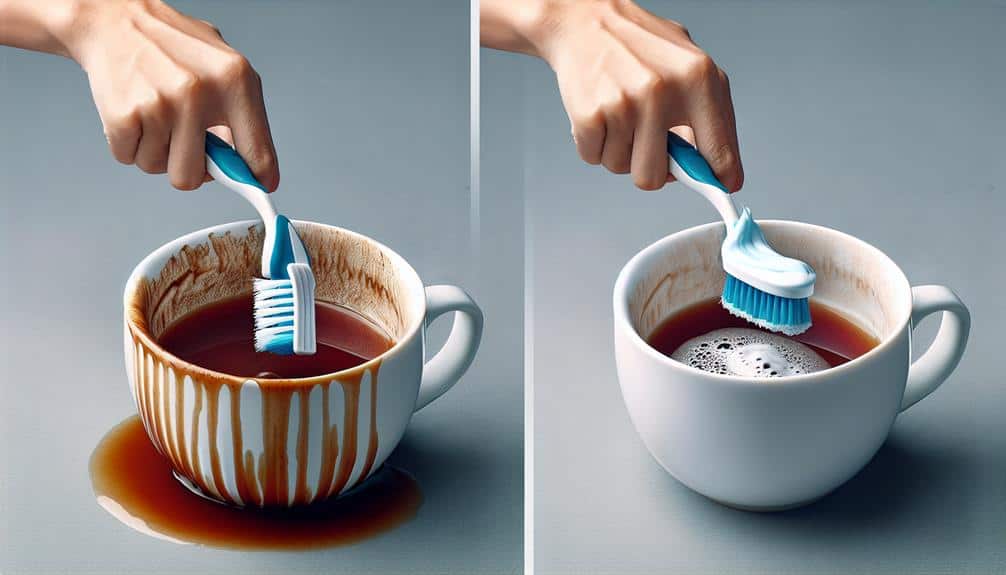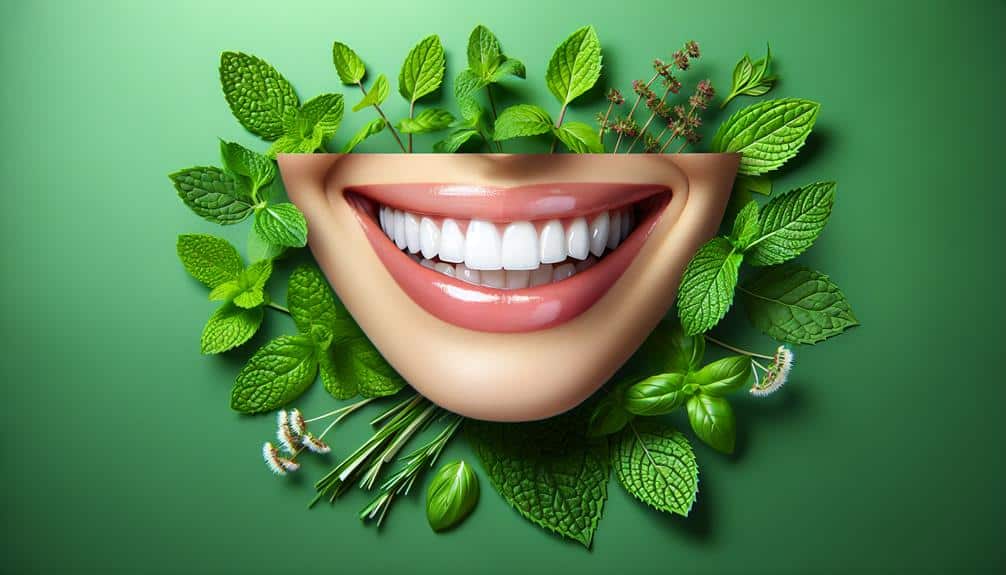Combat tea stains effectively with toothpaste by selecting a brand containing hydrogen peroxide or baking soda, which are proven to tackle stains. When using whitening toothpaste, apply a pea-sized amount on a soft-bristled toothbrush and brush gently in circular motions for two minutes, focusing on stained areas. For maximum effectiveness, avoid excessive foaming by using a small amount of toothpaste, and consider mixing it with baking soda sparingly. If you follow these tips, your tea stains will be no match for the power of whitening toothpaste.
Key Points
- Choose toothpaste with baking soda or hydrogen peroxide for effective tea stain removal.
- Focus on brushing problem areas with prominent tea stains for better results.
- Use a pea-sized amount of toothpaste to prevent excessive foaming.
- Brush for at least two minutes to ensure thorough stain removal.
- Consider mixing toothpaste with baking soda for a homemade stain-removing paste sparingly.
Best Whitening Toothpaste Options
When selecting the best whitening toothpaste for combating tea stains, consider options with proven whitening agents like hydrogen peroxide or baking soda. These toothpaste ingredients are effective in removing stubborn stains caused by tea consumption. If you have teeth sensitivity, it's important to choose a whitening toothpaste that's specifically formulated for sensitive teeth. Look for ingredients like potassium nitrate or fluoride, which can help alleviate sensitivity while still providing whitening benefits.
Toothpaste with hydrogen peroxide is known for its powerful whitening properties. It penetrates the enamel to break down stains effectively. Baking soda, on the other hand, is a gentle abrasive that can help scrub away surface stains without causing damage to the teeth. Both ingredients are commonly found in whitening toothpaste and are suitable for combating tea stains.
When browsing for whitening toothpaste options, read the labels carefully to make sure they cater to your specific needs. Consider consulting with your dentist to find the best whitening toothpaste that suits your teeth sensitivity while effectively targeting tea stains.
How to Use Whitening Toothpaste
To effectively use whitening toothpaste, apply a pea-sized amount to a soft-bristled toothbrush and brush your teeth gently in small circular motions for at least two minutes. Whitening toothpaste offers several benefits beyond just cleaning your teeth.
Here are some techniques to help you make the most out of your whitening toothpaste:
- Consistent Application: Use whitening toothpaste twice a day for best results.
- Avoid Excessive Pressure: Brushing too hard can damage your enamel, so use gentle pressure.
- Focus on Problem Areas: Concentrate on areas where stains are more prominent to maximize the whitening effect.
- Rinse Thoroughly: After brushing, make sure you rinse your mouth thoroughly to remove any residual toothpaste and stains.
Tips for Maximizing Toothpaste Effectiveness
Maximize the effectiveness of your toothpaste by implementing these practical tips for maximum oral hygiene. For tea stain removal, choose a toothpaste containing baking soda or hydrogen peroxide, as these ingredients are known for their whitening properties. When brushing, focus on the areas where tea stains are prominent, using a pea-sized amount of toothpaste to avoid excessive foaming which can maximize effectiveness. Additionally, consider brushing your teeth for a full two minutes to guarantee the toothpaste has enough time to work on removing stains effectively.
Toothpaste hacks can further enhance its effectiveness. You can mix a small amount of toothpaste with baking soda to create a homemade stain-removing paste. Remember to use this mixture sparingly, as baking soda can be abrasive and may damage tooth enamel with excessive use. Another hack is to apply a dab of toothpaste directly onto the stain, leaving it on for a few minutes before gently scrubbing with a soft-bristled toothbrush.
Frequently Asked Questions
Can Any Type of Toothpaste Be Used to Combat Tea Stains, or Does It Have to Be Specifically a Whitening Toothpaste?
You don't need a specific whitening toothpaste to combat tea stains effectively. Some natural remedies suggest regular toothpaste can work just as well. Experiment to see what suits you best for a brighter smile.
How Long Does It Typically Take to See Results When Using Toothpaste to Remove Tea Stains From Teeth?
For speedy results, toothpaste efficacy in stain removal varies. Generally, noticeable improvements can be seen within a few uses. Long term effects depend on consistency and the severity of the stains. Regular use is key.
Are There Any Potential Side Effects or Risks Associated With Using Toothpaste as a Stain Remover?
When using toothpaste as a stain remover, it's important to be cautious of potential risks like enamel damage. Despite this, the advantages of its whitening properties are great. To guarantee safety, follow usage precautions diligently.
Is It Safe to Use Toothpaste to Remove Tea Stains on a Daily Basis, or Should It Be Done Less Frequently?
Using toothpaste daily to remove tea stains is generally safe, but it's best to do it less frequently to avoid potential abrasive effects on enamel. Consistency is key for effectiveness; consider alternating with gentler methods.
Are There Any Specific Techniques or Methods That Can Help to Make Toothpaste More Effective in Removing Stubborn Tea Stains From Teeth?
To make toothpaste more effective in removing stubborn tea stains from teeth, guarantee thorough toothpaste application on stained areas. Utilize gentle circular motions with your toothbrush to target stains. Prevent future stains by exploring DIY alternatives like baking soda or hydrogen peroxide.



